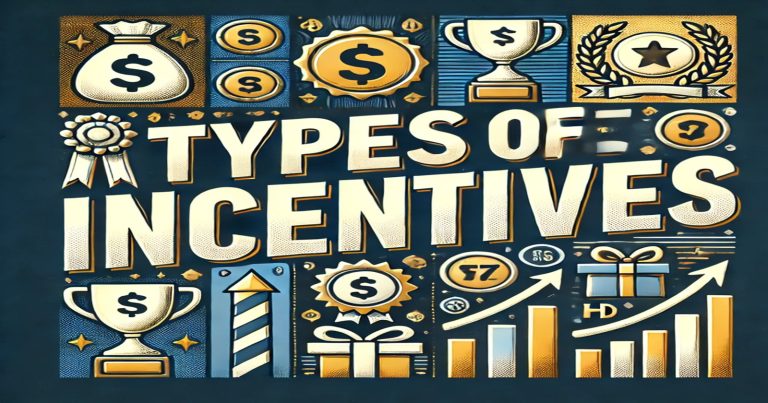Incentives are important for encouraging individuals to perform better. In business, education, or healthcare, incentives encourage people to work harder and reach their goals. Types of incentives are financial or non-financial, provided to individuals based on their performance, loyalty, or productivity. These incentives vary in their structures according to the goals and policies of the organization. Employers use various types of incentives plans to improve productivity and boost morale among the employees. Various types of incentives schemes are used in different industries to motivate better performance.
Organizations in every industry rely on various financial and non-financial incentives to keep the employees motivated. The incentive system of a company ensures that employees are engaged and working towards business goals. Businesses design incentives according to their long-term goals and the needs of employees. The better an incentive plan aligns with the interests of employees and business objectives, the more effective it will be. This paper discusses what an incentive is, its types, classification, and overall importance.
What is Incentive?
An incentive is anything that encourages or motivates a person to take a specific action. In business, incentives help increase productivity, improve efficiency, and create a positive work environment. Organizations use incentives to reward employees for their hard work and loyalty. They can be financial, like salaries and bonuses, or non-financial, like recognition and flexible work hours.
Incentives are not limited to businesses. Governments reward investments, healthcare professionals reward healthy behaviour, educators reward students, and companies design numerous types of incentive plans to achieve business objectives. The right incentive strategy motivates employees to engage and have higher overall productivity. Employees feel valued and motivated to do better when the reward is commensurate with employee efforts. An effective incentive structure helps businesses retain talent, boost efficiency, and create a positive work culture.
Types of Incentives
Incentives can be broadly categorized into financial incentives and non-financial incentives. These different types of incentives cater to the diverse needs of employees and individuals in various fields. Organizations use various incentive structures to ensure employees remain satisfied and perform at their best.
- Financial incentives– The direct monetary rewards include salaries and bonuses or stock options. The human resource of the organization ensures that an employee will become more productive and efficient in the workplace. This means he or she will be committed to the company knowing that certain benefits will financially secure their needs.
- Non-monetary incentives – They do not deal with direct monetary benefits but work on motivation based on recognition, career growth, or better working conditions. The employees appreciate the non-monetary incentives because it enhances their experience at work, and they offer long-term advantages such as the development of skill and job satisfaction.
Organizations use a combination of financial and non-financial incentives to enhance performance. Some companies create specific types of incentives schemes to meet employee retention, motivation, and productivity. An incentive plan works effectively if it is aligned with employees’ personal goals and the objectives of the company. The appropriate combination of incentives motivates employees to deliver better work and strengthens loyalty among them.
Financial Incentives
Financial incentives refer to monetary rewards given to individuals or employees to enhance performance, encourage loyalty, or achieve organizational objectives. These types of financial incentives include direct payments, bonuses, commissions, and other financial benefits that improve an employee’s earnings. Employees value financial incentives because they provide immediate rewards for their efforts. Financial rewards also create a sense of competition in the workplace, pushing employees to perform better.
1. Salary and Wages
The most fundamental form of monetary incentive is a fixed salary or wage. A predetermined amount based on the role, experience, and industry-standard is given to the employees. Organizations also provide increments in salaries to reward consistent performance by employees. Salary-based incentives ensure the employees’ financial stability is ensured so they feel secure in their jobs. Competitive salary structures also help attract top talent because professionals seek jobs that provide financial growth.
When firms base their increments on performance, employees are motivated to work harder. A well-analysed and stipulated salary plan ensures that employee efforts and company goals are aligned. Improved wage compensation results in improved job satisfaction and reduces turnover rates. Those whose wages appear fairly computed are likely to stay loyal.
2. Bonuses
Bonuses are the extra payments awarded to employees in case they reach or surpass their targets. Most companies have bonuses as part of their types of incentives plans to promote high performance. Bonuses work as instant financial rewards that prompt employees to work beyond expectations.
Companies can have various types of bonuses:
- Performance-based bonuses – Awarded in case of meeting specific targets. These bonuses urge employees to achieve deadlines and complete quality work.
- Festival bonuses – These bonuses come along during festivals. The bonuses, along with festivals, boost employee satisfaction and goodwill between employers and employees.
- Year-end bonuses – These bonuses are paid to the employees for their whole year of contributions. These bonuses make the employees stay back in the organization.
Rewards make the workers feel valued, and a designed bonus plan elevates employee participation and fosters a high-performing culture. When employees are rewarded for their efforts through monetary means, they will work extra hard to avoid inconsistency in work.
3. Commissions
Sales-based roles usually comprise a financial incentive, such as being paid commissions. Employees receive a percentage of the sales they generate. The more an employee works, the more they get compensated.
Commissions are widespread in real estate, insurance, and retail industries. A commission-based structure ensures that employees are paid based on their productivity. Companies benefit from commission-based incentives because they encourage employees to improve their sales skills. Employees also develop strong client-handling abilities when motivated by commissions.
A well-structured commission plan will ensure that the employees are determined and focused. Businesses that use commissions will attract more revenues in return. The employees will own their work because they are being rewarded based on their contributions.
4. Profit Sharing
Profit-sharing is an arrangement in which employees share the profits of a company. It will then result in employees being directly involved with the organization so that they may work towards the growth of business.
Companies take on the profit-sharing plan as a form of equitably distributing the profit earned among employees. Such incentives promote the feelings of belonging to the organization. When workers can identify directly with the performance and outcome of an organization, then they work effectively toward achieving corporate objectives.
Profit-sharing plans enhance teamwork and cooperation as employees work towards increasing profits. When businesses share profits, employees feel appreciated, thus becoming more attached to the company.A proper profit-sharing system fortifies employee loyalty and the rate of turnover.
5. Stock Options
Stock options are offered to employees by most companies, especially startups. It gives the worker shares of the organization, thereby making the interest of the employee’s finances merge with the company’s growth.
Employees with stock options become partial company owners, hence motivated to contribute to business growth. Stock-based incentives attract the best talent as professionals seek opportunities that offer long-term financial benefits. When stocks’ value increases, employees are encouraged to put in more effort.
Companies offering stock options have improved retention rates for employees. Workers feel financially connected to the company’s prosperity and are not likely to quit.A successful stock option program increases productivity as workers work hard to increase the price of the company.
Non-monetary Encouragement
Non-medial incentives are based on other inspirations other than monetary awards. These incentives enhance job satisfaction, career development and commitment to workplace. Most companies develop various types of incentives schemes with non-monetary rewards to create a positive work culture. Non-monetary incentives are as essential as monetary ones because they address the emotional and psychological needs of employees. The employees are likely to be loyal to a company that offers recognition, career development, and a supportive work environment.
1. Recognition and Awards
This also inspires employees at work, receiving appreciation for a job well done. Recognition among employees in respect to prizes or public acknowledgment improves morale. As recognition increases self-worth feelings among employees about their work value, commitment about the job increased.Organizations use prizes such as staff employees to highlight and reward extraordinary performances.Public recognition may prove to be more efficient than any kind of monetary reward. When an employee is appreciated in the presence of their colleagues, it puffs off his chest and motivates him to work toward that level. It leads to a good working environment as well. Employees who receive daily appreciation work harder as they are more productive. Companies that do not appreciate their employees face higher rates of turnover
2. Career Growth and Development
If one offers employees opportunities for development, such as promotion or the acquisition of particular skills, people tend to work for an organization. Companies in employee growth develop high engagement levels and low turn-over rates because they feel career development is attainable.
These forms of incentives involve training programs, mentorship, and job rotation. Companies invest in employee education, which results in a highly skilled workforce. The result of training involves increasing the confidence of the workers to perform, consequently increasing efficiency. Career growth incentives also ensure better retention of employees, as no one likes to leave a company that supports their long-term professional goals. Organizations fail at career development, thereby losing talented employees to competitors.
3. Flexible working hours
Many organizations offer flexible work hours for the satisfaction of employees. Thus, it makes the employees better productive and reduce stress. People appreciate the time management according to individual needs.
Flexible work arrangement includes remote working, flexible shift, and compressed work week. These options allow employees to control their schedules and balance their personal and professional lives, thus increasing job satisfaction. Such employees are likely to be more productive and more engaged at work. Companies offering flexibility attract the best talent, as professionals value work-life balance. Flexible incentives are a major non-monetary reward because rigid work schedules lead to burnout and decreased productivity.
4. Job Security
Job security is as important as monetary rewards for employees. The employment conditions in a company ensure stability, thus gaining the confidence and loyalty of the workers. Job security ensures that the employee concentrates on their work without any fear of abrupt layoff.
Companies with job security foster a loyal employee base. People work better when they are safe in their employment. Companies that have job security usually have less turnover. Fear of losing the job makes some employees demotivated and low in productivity. A good policy on job security gives employees comfort and a friendly work environment.
5. Working Environment and Culture
A great workplace culture builds employee motivation. A work environment that is healthy, inclusive, and engaging becomes a non-financial motivating incentive. It thrives within working environments which cultivate collaboration between different employees communication, and respect.
Open communication, teamwork, and ethical leadership create a supportive work environment. Their employees can contribute their best work if their workplace makes them comfortable. Companies prioritizing work culture have the most likely skilled professionals. A toxic work environment creates high stress, lesser productivity, and most turnover. A workplace culture is a good inducement for creativity, innovation, and job satisfaction.
6. Other Benefits
Non-monetary incentives can include household membership, such as gym membership, childcare support and free food. Such benefits enhance the positive work environment, which raises the satisfaction of the overall job. Employees like extra allowances that enhance the general quality of their lives.
Companies offer many fringe benefits to engage and motivate employees. Such benefits make the employees feel valued than their salary draws. Wellness programs, travel allowance, and team-building activities also play an important role in employee satisfaction.Organizations that offer unique benefits will have an advantage over others in attracting and retaining the best employees. Those employees who enjoy greater benefits will be more attached to their organizations as well.
Classification of Incentive Scheme
Depending on the aims of various organizations, incentives could be of diverse forms. For their objective and purpose, incentive plans can fall into two major broad groups as follows:.
1. Individual Incentive Plans
They pay the individual employees based on your performance. Employees are directly rewarded for their efforts and therefore motivated to perform well. Examples include:
- Peace wage incentives: are paid to encouragement-employees how many units they produce. This method is common in manufacturing industries where productivity will easily determine how much the employee earns. Employees work hard to increase their production, enhancing the company’s performance.
Merit-based incentives – Rewards driven based on the employee’s specific merits. Companies use this method to motivate high performance and to reward excellence. Merit-based incentive employees feel valued and are motivated to continue performing better.
2. Group Incentive Plans
Group incentive plans reward teams for their collective efforts. Organizations encourage teamwork by providing shared bonuses or profit-sharing options. Group incentives foster collaboration and improve team dynamics.
Companies use group incentives to give employees a sense of shared responsibility. Employees build more professional relationships when working towards common goals. Group incentives reduce employee competition, leading to a more cooperative work environment. Increased efficiency and better project outcomes result from successful teamwork.
3. Organizational Incentive Plans
These incentives are on the performance of the whole organization. Companies can provide stock ownership plans or company-wide bonuses that tie the employees’ goals with the success of business. Organizational incentives make the employees contribute to the long-run growth of business.
When employees have some stake in a company’s success, it is likely they will remain devoted. Stock ownership plans keep them engaged and motivated. Organizational incentives also tend to make more loyal employees due to direct payoffs from business growth. Companies with incentives for the organization tend to hold onto their workers longer and show greater job contentment.
Incentive System
An incentive system is a structured plan designed by organizations to reward and motivate employees. It is a mix of financial and non-financial incentives to align employee performance with business goals. A well-structured incentive system helps organizations retain talent, improve efficiency, and create a competitive work environment.
A well-designed incentive system ensures:
- Employees stay active and motivated – With a promise of reward to employees, the former work much more enthusiastically.
- Productivity rises– Incentives motivate individuals to work toward high performance level so that the organization could be quite efficient and performative.
- Efficient achievement of organizational goals – The incentives relate individual efforts towards achieving the firm’s long term objectives.
Organizations continuously update their incentive systems as per market trends, employees expectations and commercial goals to keep them effective and relevant. A well -employed system reduces employee turnover, increases job satisfaction, and increases overall organizational performance.
Importance of Incentives
Incentives are crucial for business success because they drive motivation, improve job satisfaction, and increase employee retention. A strong incentive plan can transform workplace culture and improve business performance.
Here’s why incentives are important:
- Increase Productivity – Employees work harder when awarded for their performance. Financial rewards such as bonuses motivate employees to go above and beyond. Non-financial incentives, like recognition, create long-term motivation
- Make Employees Happy – A well-designed incentive system has increased morale levels, whereby they feel valued. Happy employees will be more committed to their work.
- Encourage Loyalty – Employees remain longer with the companies that recognize and reward their efforts. An effective incentive program decreases employee turnover and increases retention.
- Attract Top Talent– Organizations with sound incentive plans attract skilled professionals. Competitive salaries, career growth opportunities, and positive work culture make businesses desirable employers.
When businesses prioritize incentives, they create a motivated workforce that consistently meets performance expectations. Incentives are key to maintaining a high-performance work environment.
Incentive Variables
Incentive variables refer to the factors that influence how well an incentive system works. These variables ensure that employee rewards effectively motivate them to perform better.
- Performance Metrics – These are the standards by which one measures an employee’s performance. Companies will set clear performance standards in terms of sales targets or customer satisfaction ratings, which will be used to qualify for incentives.
- Employee Expectations – Incentives must be aligned with what employees value. While some employees value monetary incentives, others might be more motivated by promotions, recognition, or flexible work arrangements.
- Company Goals – The reward system should reflect the business long-term goals. If a business wants to become better at offering customer service, it should use incentives that support the employees’ delivery of higher-quality customer services.
- Market Trends – Industry trends determine the incentive businesses provide to employees. Business should be up to date on what is in demand and have incentives that keep them competitive enough to retain their employees and also attract new employees.
Types of Incentives FAQs
1. What are the different types of incentives?
The types of incentives include financial incentives such as bonuses and stock options, and non-financial incentives such as recognition and career growth. Both categories help motivate employees and improve productivity.
2. What are types of incentives plans?
There are individual, group, and organizational incentive plans. Individual plans reward personal achievements, group plans encourage teamwork, and organizational plans align employees with company success.
3. How does an incentive system work?
An incentive system establishes structured prizes to motivate employees. It involves financial and non-financial incentives to increase performance and satisfaction.
4. Why are the incentives important in HRM?
In HRM, incentive employees increase engagement, reduce turnover, and increase job satisfaction, thus ensuring a productive task force.
5. What are the types of incentives spiometer?
Incentive spirometers are medical devices that encourage deep breathing by providing a visual reward for inhaling correctly, helping improve lung function.


